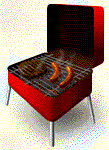(Our thanks to Peggy Pride, who demonstrated this at the 1998 AP Reading.)
Objective
To demonstrate the concept of scarcity and the issue of "economizing"
Materials
4 large envelopes 3 pencils
2 scissors
1 ruler
1 bottle of glue 1 ink pen
12 paper clips
8 sheets of paper (8.5x11): 1 blue, 1 green, 1 white, 2 red, 3 yellow
Set-Up
Assemble envelopes for 4 groups; label the envelopes as Country 1, 2, 3 or 4.
| 1 – 1 scissors, 2 pencils, 1 bottle of glue, 2 paper clips, green paper (half sheet), 1 yellow paper, 1 blue paper | |
| 2 – 1 ruler, 6 paper clips, 1 yellow paper, 1 pencil, 1 ink pen | |
| 3 – 1 scissors, 4 paper clips, green paper (half sheet), white paper (half sheet) | |
| 4 – White paper (half sheet), 2 red papers, 1 yellow paper |
Instructions
| Divide class into 4 work groups | |
| Show the tasks to be completed on overhead or hand out copy to each group | |
| Distribute envelopes randomly | |
| Inform students that they have 15 minutes to complete all of the tasks | |
| Allow students to trade but only if a group asks if trading is allowed | |
| At the end of time, let each group show its completed project tasks. Use the follow up questions to analyze the exercise. |
Tasks to be Completed
 |
FOOD: four 3-inch strips of green paper |
 |
SHELTER: 2-inch white square attached to a yellow triangle |
 |
CLOTHING: a four-color paper chain |
 |
EDUCATION: a four-page book with color cover |
Follow Up Activities
Let class critique the products:
Distinguish between quality and quantity
Let group decide if projects were completed
Ask about the types of resources that each group was given initially.
| Ask why there was a difference between envelopes. (Scarcity of resources) | |
| Ask about the different types of resources. Ask students to classify the items in the envelope (Paper – land; Capital – scissors, pencils, pen, glue, ruler; Labor – the students; Entrepreneurship – their creativity in production.) | |
| Discuss the trading - for – resources aspect of the game | |
| Did any group "have it all"? | |
| How was trading facilitated? | |
| Did any group ask or use the envelope? | |
| Were there resources not needed? | |
| Were any useless or not tradable? | |
| Could additional products be created? |
Inquire about the factor of labor in this game.
| Stress the thinking process of solving the scarcity issue by improvising. Let students talk about how the production process was organized. | |
| Did anyone take charge? Did just one person do the assembly of the task products? | |
| Did anyone discover that since the whole sheet of paper was 8.5x11, they could divide it and use it as a ruler? |
Inquire about the factor of capital (tools, machines)
| No ruler? No glue? No writing utensil? Solutions? |
| Would other types of capital been useful? |
Lastly, try to help students to see the connection to the principle of Scarcity as defined:
| Limited Resources vs. Unlimited Wants | |
| Demand for goods and services exceeds the supply | |
| Human wants tend to be unlimited, but human, natural, and capital resources are limited. |
Conclude the lesson with a discussion of ways to deal with scarcity:
| People can do without some of the things they want. | |
| People can create more resources by new discoveries, more training, better tools | |
| People can produce more by better use of resources | |
| People can redistribute goods and services so that everyone has enough. |
NOTES
As later topics are introduced, you can refer to this exercise. For example, reference to the distribution of the resources can be referred when studying comparative advantage. The idea of opportunity cost and trade-offs as a part of the concept of production possibility curves can be stressed in the idea that the groups needed to make choices about how to produce, whether to trade and what to trade.
This game works well in the beginning of the term when the students need to be motivated. It is a good introduction to thinking about economic terms.